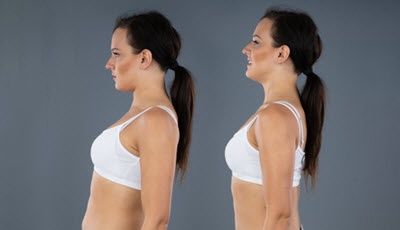 You want to sit up straight but aren’t quite sure what to do.
You want to sit up straight but aren’t quite sure what to do.
So, you try harder. Do more.
You put effort into sitting up straighter. Hold yourself in position longer.
You fidget and fuss but can never seem to get your shoulders in the right position or your head where it should be.
The answer is not what we need to DO…
… it’s what we need to STOP DOING.
We all have bad habits in how we sit, stand, and move. Often, the harder we try to fix them, the worse they get.
The effort we put into sitting up straight is just tightening up our back muscles. And holding our shoulders back just creates tension. Our efforts fail because we are trying to move or hold parts of our body as if they aren’t integrally connected to the rest of ourselves.
That shoulder tension we just created? It is also stiffening our neck and encouraging our legs to work harder than they need to just to sit. And the more we try, the worse we make it.
You may not realize that you already have the capacity to use yourself well – to move in a coordinated way and stand with alignment and poise. You just need to understand what habits are getting in the way and learn how to stop them.
 Highlighting what’s holding you back…
Highlighting what’s holding you back…
During your initial Alexander Technique consultation, I will take pictures of your posture in sitting, standing, and common movements. With a postural assessment, I will use your pictures, intake questionnaire input, and my observations and analysis from your first Alexander lessons to assess two things:
First, to highlight your dominant habits. I will overview what I see in the regions of your body (head, neck, back, arms, legs, and eyes) and aspects of your attention and approach to activities, discussing habits such as stiffness or passiveness, lifting or collapsing, over-contractedness or disconnectedness, inattentiveness or fixation.
Second, I will present a road map for how the Alexander Technique will address these habits. We will discuss how the principles and practice of the Alexander Technique will address your particular habits and allow you to overcome those habits in general and in relation to activities that are important to you.
A postural assessment vis-à-vis the Alexander Technique can point out those habits that are interfering with your standing and moving as well as possible – those things that are holding you back.
 See yourself how other people see you.
See yourself how other people see you.
Through pictures and clear descriptions, I can clarify what really matters about how you sit, stand, and approach your activities.
You can use this information to guide what you work on in your personal practice while taking Alexander lessons and look back at after a series of lessons to see just how much progress you have made.
Want to learn what is holding you back? Schedule an online consultation.

